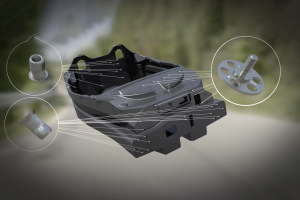
Fastening systems play a crucial role in the performance and integrity of sandwich panels made with composite materials. A proper fastening system for composite materials ensures that the sandwich panel is firmly attached to its support
The choice of the fastening system depends on the materials used for the sandwich panel, the application, and the required performance. Different Various fastening systems, such as mechanical fasteners, adhesive bonding, and hybrid fastening systems, are used for sandwich panels.
The importance of fastening systems with composite materials
Mechanical fasteners, such as rivets, screws, and bolts, are commonly used to join sandwich panels. The fastener’s size, shape, and spacing must be selected to avoid creating stress concentrations or deforming the panel.
Adhesive bonding is also commonly used for joining sandwich panels. The adhesive must be compatible with the materials used in the sandwich panel and be selected based on the application and required performance.
Hybrid fastening systems, which combine mechanical fastening and adhesive bonding, provide additional load transfer capacity and can improve the sandwich panel’s performance.
In summary, choosing the right fastening system is crucial for the performance and durability of sandwich panels, and it must be done with careful consideration of the materials used, application, and required performance.
Composite materials and fastening systems: challenges for manufacturers
Fastening systems are an important consideration when working with composite materials, as the properties of these materials can present unique challenges. Some of the issues that can arise with fastening systems in composite materials include:
Delamination: composite materials can be prone to delamination, which can occur when fasteners are installed improperly or when the joint is subjected to stress or fatigue. Delamination can weaken the joint and lead to joint failure.
Galvanic corrosion: composite materials often require the use of dissimilar metals for fastening systems, which can lead to galvanic corrosion. Galvanic corrosion occurs when two dissimilar metals are in contact with each other and are exposed to an electrolyte, such as water or saltwater. This can weaken the fastener and lead to joint failure.
Overdriving: overdriving occurs when the fastener is overtightened, causing the composite material to crack or split. Overdriving can weaken the joint and lead to joint failure.
Creep: creep occurs when the composite material deforms over time under a constant load. This can cause the fastener to loosen or the joint to fail.
Fatigue: repeated loading and unloading of a fastener or fastening system can cause fatigue, leading to cracking, deformation, or failure of the joint.
Improper installation: even if the right type of fastener or fastening system is used, improper installation can lead to joint failure. Common installation errors include overtightening or undertightening the fastener, using incorrect torque settings, or failing to properly align the fastener with the joint.
Vibration: vibrations can loosen fasteners over time, leading to joint failure. This is particularly problematic in applications where the joint is exposed to frequent or intense vibrations, such as in automotive or aerospace applications.
Explore Our Comprehensive Range of Solutions for Composite Materials.




